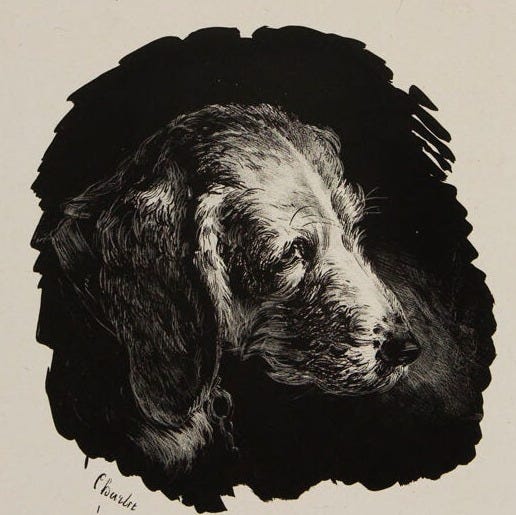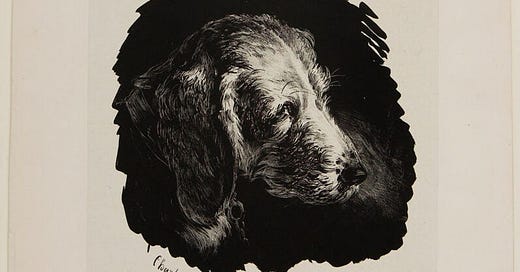Thanks to everyone who has recently subscribed to The Ink-Stained Desk. If you enjoy this free publication, consider supporting my work through the ‘Buy Me A Coffee’ button. A small amount goes a long way in supporting my writing.
I also publish SubStack’s The Link Drop, where each Sunday I curate 5-10 links to thought-provoking articles, spanning diverse topics and including a weekly gem from JSTOR. Never politics or celebrity culture, consider it your antidote to the endless social media scroll, offering substance and sparking curiosity. If this sounds like it might add value to your week, head over and take a look around.
Welcome, welcome, welcome!
This week at The Ink-Stained Desk, I have been thinking about dogs in horror stories. Now, before all of you soft hearts (—not an insult, I’m firmly standing on your side of the ‘don’t kill the dog’ line), click out of this article. That’s not what I’m talking about this week.
I received an advanced reader copy of T. Kingfisher’s upcoming release (—of which she has three this year! Can we all say ‘prolific writer’), Snake-Eater and while reading it, I became completely and utterly smitten with the main character’s canine companion, Copper, a black Labrador, who, without actually being able to speak, is all at once snarky, loving and very brave.
“Copper looked up, clearly wondering if the word had anything to do with her, and whether it might lead to a trip Outside or, better yet, a Treat.” Snake-Eater - T.Kingfisher.
This got me thinking about dogs in horror and what they offer to this genre as a whole. I began turning through some of the notes I made while reading other standalone novels by T. Kingfisher, and have some thoughts on her use of dogs and the whimsical relief they offer to the tension of her plots.
Kingfisher herself, in the acknowledgements of Snake-Eater, says:
“If I was going to describe the platonic ideal of a Kingfisher horror novel, it would probably be a woman and her dog alone in a house full of creepy family secrets.”
Specifically, this week I looked at the books:
The Twisted Ones, with a Redbone Coonhound named Bongo.
Snake-Eater, with a black Labrador named Copper.
Nettle & Bone, with a dog literally made of bones and held together by magic, named Bonedog.
But you don’t have to have read any of these books in order to understand what I’m talking about below. Also, if you know of any other titles (not necessarily by T. Kingfisher) where a dog (or other animal companion) offers comedic relief within a horror plot, please share them in the comments.

Alright, so let's talk about T. Kingfisher. If you've ever dipped your toes into her unique world of horror, fairy tales gone sideways, and dry humour, you know she's a master at crafting stories that get under your skin while still making you snort-laugh. But as I mentioned above, there's something else that pops up consistently in her standalone novels, something furry and four-legged that always seems to steal the show: her amazing canine companions.
These dogs aren't just background characters. These dogs are often the only things keeping the main characters going – they are anchors, the snuffling beacons of normal within the horror, and seriously, the best comic relief when things get weird and creepy (—which they often do in Kingfisher’s books). They give her protagonists someone to lean on when their world goes completely nuts.
So, I guess the big question I’m exploring here is: why do we (—maybe just I) love these dogs so much, and why, against all the odds, do they always make it out alive?
Laughing Through the Horror, Thanks to a Dog.
Kingfisher's a genius at using her dogs to hit the brakes on the horror. While ancient evils are waking up or sneaky fae are messing with reality, the dogs are just... being dogs. Think about Bongo, the majestic "Good Boy" from The Twisted Ones. Jesse, our main character, is stuck in her creepy grandma's house that's literally shifting around and humming with bad vibes. Meanwhile, Bongo's biggest worries are perfecting his ear-splitting snoring or launching a full-scale campaign to get another treat.
“Bongo sat up and came over to the window. He licked the screen and seemed puzzled that it tasted like wire. “You’re not smart,” I told him. He wagged his tail and licked the screen again, on the off chance that it had become tasty.” The Twisted Ones - T.Kingfisher.
We enjoy similar behaviour (—or misbehaviour) from Bonedog.
“Bonedog, bored, sat down and began trying to lick his nether regions. Since he had neither tongue nor anything to lick, this accomplished nothing but seemed to please him.” Nettle & Bone - T. Kingfisher.
That absolute single-minded focus on dog stuff is such a sharp contrast to the terrifying stuff happening, like walls bleeding or woods whispering dark spells. Their doggy priorities give us (and the characters) a much-needed break from the fear. You can almost feel yourself taking a deep breath (—and if you're anything like me, snorting and smiling over at my own dogs) before the next scare hits. It's brilliant!

Furry Hugs and Unbreakable Loyalty
It must be noted that these dogs are more than just a laugh track. They're a huge source of comfort and unwavering loyalty. When Kingfisher's characters are feeling totally isolated or just plain losing it, these canines are there, a warm weight against their leg, a wet nose in their hand, a constant reminder that something good still exists in the world. In The Twisted Ones, Bongo is Jesse's rock. When the nightmares are closing in, just having his solid, snoring weight in the bed is enough to keep her from completely falling apart. Similarly, in Snake-Eater, the only way that Selena can settle for the night alone in the desert house is with Copper on the bed with her (—and as is the way of Labrador, taking up most of the space on the bed).
Their loyalty is truly something else, a pure, uncomplicated kind of devotion in stories that are often packed with betrayal and ancient nastiness. They don't ask for much, maybe a good ear scratch and a treat every now and again, but they give absolutely everything. More than not taking a huge part in the final battle scenes.
“and then Copper, who was valiant and ridiculous and probably thought that she had defeated this monster all by herself, bounded forward and sank her teeth into…” (—quote cut short because spoilers!) Snake-Eater - T. Kingfisher.
And the fact that they always survive? That's a huge deal, and I like to think that it's a quiet but powerful message that even after facing down pure evil and seeing the darkest corners of the world, simple joy and loyal companionship can still win. Their happy sighs and contented snores at the end of a book are like little victory flags, telling us that even if things are still a bit messy, the light hasn't totally flickered out.
More Than Just a Pretty Face (or a Wagging Tail)
While these dogs are masters of comedy and comfort, Kingfisher's canines aren't just sitting there looking cute. If you pay close attention, they often play a subtle but important role in the story itself. These dogs’ sudden growls at thin air, a bark at an empty spot, or frantic scratching at a door are the first clues that something seriously wrong is about to happen. Their animal instincts are usually way ahead of their human characters, acting as a built-in early warning system. Sometimes, a dog's sheer need for a walk forces a character to step into danger, because, let's be real, you're not leaving your dog behind, are you?
And here's a cool trick Kingfisher pulls: because we, as readers, generally assume the dog will be okay (—it's a Kingfisher book, after all!), it actually makes all the other threats feel even more terrifying. It's like, "Okay, the dog's safe, so anything can happen to the humans!" It's a brilliant way to mess with our expectations. Plus, their survival often feels like a secret "happy ending" marker, even though we knew they would be okay. If the dog makes it, you can breathe a little easier, knowing that even if things are still a bit wonky, maybe, just maybe, everything will eventually sort itself out, even if it still smells a bit like old earth and weird magic.

So, when you're making your way through the wonderfully weird worlds of T. Kingfisher, don't forget to pay extra attention to the dogs that bless the pages of her stories. They're way more than just furry sidekicks. They're the heart and soul of her particular brand of horror: the essential comic relief that pulls you back from the brink, the steady emotional anchors when everything else is shaking, and quiet symbols of hope and normalcy. They remind us that even when the shadows stretch long and the unknown is knocking on the door, the world still holds simple, profound comforts. (—such as treats, belly scratches and a warm bed)
I plan to post longer reviews of the T.Kingfisher books that have been referenced here during the week. I won’t clutter up your inbox with them, but they will go up on The Ink-Stained Desk publication page this week.
Also, watch out for an announcement coming during next week regarding a new series starting over here at The Ink-Stained Desk, something for horror and fantasy readers to sink their teeth into.
See you next Friday!






I've only recently dived into Kingfisher's books with Nettle & Bone and I do have to say that Bonedog? Incredible, show-stopping, marvelous little creature! It genuinely tied the worldbuilding just that bit tighter for me, because it was a more consistently tangible reminder that this was a setting of fantasy and on the rather dark side of the whimsical! I'll be taking this as a cue to look at Kingfisher's other books as well!
Great post! The fact that I remember Bongo by name - I’ve read the book maybe 6 years ago and I don’t remember human characters name after a week - shows how great canine character he was.